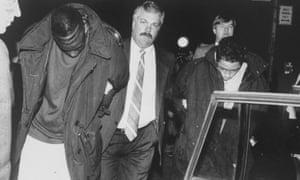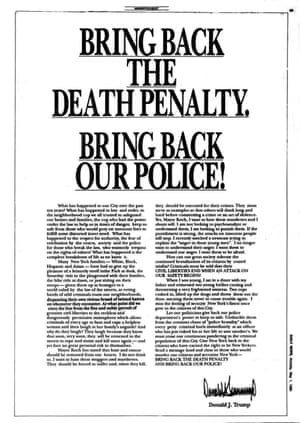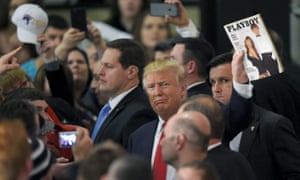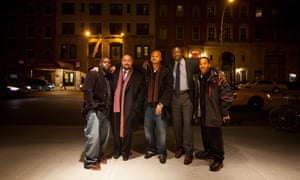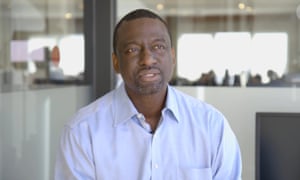In 1989 five young black men were wrongfully convicted of raping a woman jogging in New York City. Leading the charge against them was a real estate mogul whose divisive rhetoric can be found in his presidential labor today
Yusef Salaam was 15 years old when Donald Trump demanded his execution for a crime he did not commit.
Nearly three decades before the rambunctious billionaire began his run for president – before he called for a ban on Muslims entering the United States, for the expulsion of all undocumented migrants, before he branded Mexicans as “rapists” and was accused of mocking the disabled – Trump called for the reinstatement of the death penalty in New York following a horrific rape case in which five teenagers were wrongly convicted.
The miscarriage of justice is widely remembered as a definitive moment in New York’s fractured race relations. But Trump’s intervention – he signed full-page newspaper advertisements implicitly calling for the boys to die – has been gradually overlooked as the businessman’s chances of winning the Republican nomination have rapidly increased. Now those involved in the case of the so-called Central Park Five and its aftermath say Trump’s rhetoric served as an unlikely precursor to a unique brand of divisive populism that has powered his rise to political prominence in 2016.
“He was the fire starter,” Salaam said of Trump, in his first extended interview since Trump announced his run for the White House. “Common citizens were being manipulated and swayed into believing that we were guilty.”
It was 1989. The crack epidemic had torn through New York as poverty soared to 25% and the city’s elites reaped the rewards of a booming Wall Street. The murder rate had risen to 1,896 killings a year; 3,254 rapes would be reported in the five boroughs, but only one captured the city’s extended attention and later exposed bias in its criminal justice system and media establishment.
On the evening of 19 April, as 28-year-old investment banker Trisha Meili, who was white, jogged across the northern, dilapidated section of Central Park, she was brutally attacked – bludgeoned with a rock, gagged, tied and raped. She was left for dead but discovered hours later, unconscious and suffering from hypothermia and severe brain damage.
The New York police department believed they already had the culprits in custody.
That same night, a group of more than 30 youths had entered the park from East Harlem. Some engaged in a rampage of random criminality, hurling rocks at cars, assaulting and mugging passersby. Among the group was Salaam, along with 14-year-olds Raymond Santana and Kevin Richardson, 15-year-old Antron McCray and 16-year-old Korey Wise. The teenagers – four African American and one Hispanic – would become known collectively as the Central Park Five.
They would all later deny any involvement in criminality that night, but as they were rounded up and interrogated by the police at length, they said, they were forced into confessing to the rape.
“I would hear them beating up Korey Wise in the next room,” recalled Salaam. “They would come and look at me and say: ‘You realise you’re next.’ The fear made me feel really like I was not going to be able to make it out.”
Four of the boys signed confessions and appeared on video without a lawyer, each arguing that while they had not been the individual to commit the rape they had witnessed one of the others do it, thereby implicating the entire group.
he city erupted. The case came to embody not only fears that accompanied the dramatic rise of violent crime in New York, but also its perceived racial dynamics. The case of a black woman, raped the same day in Brooklyn by two men who threw her from the roof of a four-story building, received little media attention.
‘He poisoned the minds of New York’
Just two weeks after the Central Park attack, before any of the boys had faced trial and while Meili remained critically ill in a coma, Donald Trump, whose office on Fifth Avenue commanded an exquisite view of the park’s opulent southern frontier, intervened.
He paid a reported $85,000 to take out advertising space in four of the city’s newspapers, including the New York Times. Under the headline “Bring Back The Death Penalty. Bring Back Our Police!” and above his signature, Trump wrote: “I want to hate these muggers and murderers. They should be forced to suffer and, when they kill, they should be executed for their crimes. They must serve as examples so that others will think long and hard before committing a crime or an act of violence.”
Salaam, now 41, cannot remember exactly where he was when he first saw the ads. He had no idea who Trump was. “I knew that this famous person calling for us to die was very serious,” he recalled.
“We were all afraid. Our families were afraid. Our loved ones were afraid. For us to walk around as if we had a target on our backs, that’s how things were.”
All five minors had already been paraded in front of the cameras and had their names and addresses published, but Salaam said he and his family received more death threats after the papers ran Trump’s full-page screed. On a daytime TV show two days later, a female audience member called for the boys to be castrated and echoed the calls for the death penalty if Meili died. Pat Buchanan, the former Republican White House aide, called for the oldest of the group, Wise, to be “tried, convicted and hanged in Central Park by June 1”.
“Had this been the 1950s, that sick type of justice that they wanted – somebody from that darker place of society would have most certainly came to our homes, dragged us from our beds and hung us from trees in Central Park. It would have been similar to what they did to Emmett Till,” Salaam said.
All five boys pleaded not guilty at trial the following year. The prosecution’s case rested almost entirely on the confessions they had given shortly after the incident. As would become crucial later on, there was no DNA evidence linking any of them to the crime scene and Meili, who made a miraculous recovery and testified in court, could not remember any details of the attack.
The jury found all five boys guilty. The court condemned them to prison to serve sentences ranging from five to 10 years and five to 15 years. Wise, who had remained in the city’s notorious Rikers Island jail, was sentenced as an adult.
Michael Warren, the veteran New York civil rights lawyer who would later come to represent the Central Park Five, is certain that Trump’s advertisements played a role in securing conviction.
“He poisoned the minds of many people who lived in New York and who, rightfully, had a natural affinity for the victim,” said Warren. “Notwithstanding the jurors’ assertions that they could be fair and impartial, some of them or their families, who naturally have influence, had to be affected by the inflammatory rhetoric in the ads.”
A spokeswoman for Trump’s campaign declined to comment.
An impulse to run at controversy
For many who have studied Trump’s rise to prominence, the Central Park case provided an early glimpse into how his racially charged views entered his political and tactical mindset.
“He has this penchant for what you might call otherising,” said Michael D’Antonio, the author of Never Enough, a recently published Trump biography.
“I think he knew what he was doing by taking a side, and I think he knew he was aligning himself with law and order, especially white law and order. I don’t think that he was consciously saying ‘I’d like to whip up racial animosity’, but his impulse is to run into conflict and controversy rather than try to help people understand what might be going on in a reasoned way.”
Two years before the Central Park case, Trump had briefly considered a run for president that most dismissed as a naked attempt to drum up publicity for his book The Art of the Deal, released later that year.
But he couldn’t resist the opportunity to speak in New Hampshire at the invitation of the Portsmouth Republican committee, using the platform to single out allies in Saudi Arabia and Japan while critiquing US foreign policy in the Persian Gulf. He employed the same tactics as he would in 1989, publishing full-page ads in three of America’s biggest newspapers that called for the US to impose taxes on these allies, whom he argued were “taking advantage of the United States”.
In February 2000, when Trump was again flirting with a run for the White House, he took out anonymous ads in local upstate New York newspapers, in an effort to shut down a rival casino backed by a group of Native Americans. Beneath a picture of needles and drug paraphernalia, the ad stated: “Are these the new neighbors we want?” It added: “The St. Regis Mohawk Indian record of criminal activity is well documented.”
Trump later apologised, but his biographer argued the incident underlined a “willingness to use rhetoric that other people won’t use under the guise of talking straight” that is now a fixture on the campaign trail.
After declaring in his campaign announcement that Mexico was “bringing crime” and “rapists” to the US, Trump quickly seized on the murder case of a 32-year-old white woman in San Francisco in which an undocumented Mexican migrant is the chief suspect. He has since frequently condoned and incited violence against protesters at his rallies, and has vowed to bring back waterboarding of terror suspects. In referencing a promise to issue an executive order to mandatorily execute anyone in the US who kills a police officer, he said: “We just can’t afford any more to be so politically correct.”
But examples of overt racism were perhaps kept behind closed doors in the late 1980s.
One year after the Central Park Five were convicted, John O’Donnell, a former executive who ran Trump Plaza hotel and casino in Atlantic City, New Jersey, published a tell-all alluding to his former boss’s casual racism behind closed doors.
He quoted Trump as saying: “I’ve got black accountants at Trump Castle and at Trump Plaza. Black guys counting my money! I hate it. The only kind of people I want counting my money are short guys that wear yarmulkes every day.”
In a later interview with Playboy magazine, Trump labelled his former employee a “fucking loser” but added: “The stuff O’Donnell wrote about me is probably true.”
But Barbara Res, a member of Trump’s inner circle through much of the 1980s who served as his executive vice-president in 1989, told the Guardian she never witnessed any signs of racism throughout her time at his company and was “surprised” by his inflammatory rhetoric today.
“I think he got angry when he saw what happened to that woman, and I think he reacted to it,” she said of the Central Park jogger case. “I think we were all horrified at what happened. I think everybody basically supported Donald. I don’t think he was trying to be racist – I think he was trying to be a proponent of law and order.”
For Salaam, however, the intent was explicit: “If we were white, would Donald Trump had written this in the paper?”
‘He’s still the same person’
In 2002, after Salaam had served seven years in prison, Matias Reyes, a violent serial rapist and murderer already serving life inside, came forward and confessed to the Central Park rape. He stated that he had acted by himself. A re-examination of DNA evidence proved it was his semen alone found on Meili’s body, and just before Christmas that year, the convictions against each member of the Central Park Five were vacated by New York’s supreme court.
By this point, Trump had gotten his wish: the death penalty had been reinstated in New York since 1995, at great cost to the state. It was subsequently abolished in 2007, without a single execution carried out.
Following a 14-year court battle, the Central Park Five settled a civil case with the city for $41m in 2014. But far from offering an apology for his conduct in 1989, Trump was furious.
In an opinion piece for the New York Daily News, he described the case as the “heist of the century”.
“Settling doesn’t mean innocence, but it indicates incompetence on several levels,” Trump wrote, alluding to how police and prosecutors initially involved in the case have long maintained the five boys were involved in the rape, even after the convictions were thrown out.
D’Antonio, the biographer, met with Trump shortly after the settlement was announced. The billionaire was once again considering a shot at the presidency and would, this time, actually run.
Trump was asked if he worried that his publicly confrontational style would affect his political prospects. He retorted instantly with a reference to the Central Park Five.
“I think it will help me,” he said. “I think people are tired of politically correct. I just attacked the Central Park Five settlement. Who’s going to do that?”
The biographer was shocked by what he heard. “His insensitivity and inability to adjust to reality is sometimes shocking,” D’Antonio said of Trump. “But I don’t think that he is necessarily interested in reality as others experience it or as it’s determined by the courts.
“There have been few cases of injustice that are as clear and profound as this one is, but he’s not able to consider that.”
Salaam, who said he had been scarred for life by his experiences in prison, also felt insulted. But it was the announcement last June that Trump had finally decided to run for president that was, in a way, more alarming.
“To see that he has not changed his position of being a hateful person, to see that he has not changed his position of inciting people, to see that he’s still the same person and in many ways he has perfected his sense of being that number-one inciter, you know, I was scared,” Salaam said.
He was unsurprised that Trump currently leads polling averages by nearly 20 points in South Carolina, a state that votes for the Republican nomination on Saturday and where only last year the Confederate flag was withdrawn from the state house grounds. (A survey released this week suggests 70% of Trump’s supporters in south Carolina believe that decision was wrong and 38% of his supporters wish the south had won the civil war.)
“I thought for a moment: What would this country look like with Donald Trump as being a president? That’s a scary thing,” Salaam said. “That’s a very scary thing.”

